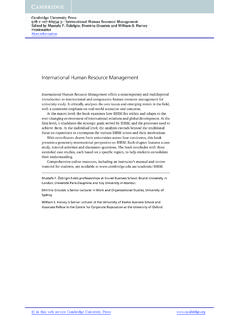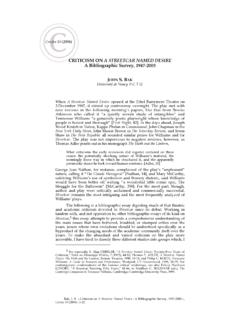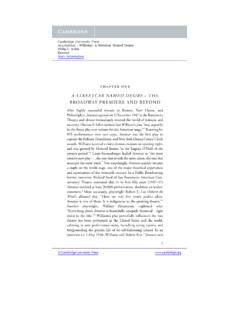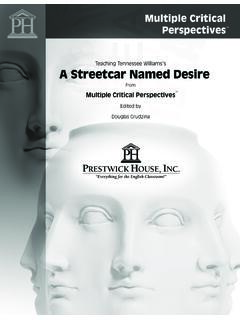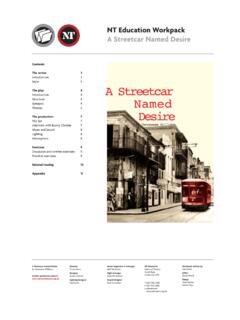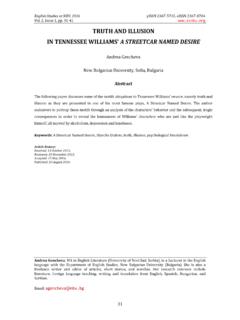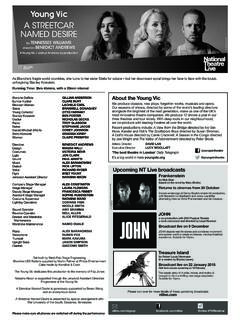Transcription of WILLIAMS: A Streetcar Named Desire - Assets
1 Williams: A Streetcar Named DesireOne of the most important plays of the twentieth century,A StreetcarNamed Desirerevolutionized the modern stage. This book offers thefirst continuous history of the play in production from 1947 to 1998with an emphasis on the collaborative achievement of TennesseeWilliams, Elia Kazan, and Jo Mielziner in the Broadway there chapters survey major national premieres by the world sleading directors including those by Seki Sano (Mexico), LuchinoVisconti (Italy), Ingmar Bergman (Sweden), Jean Cocteau (France),and Laurence Olivier (England). Philip Kolin also evaluates keyEnglish-language revivals and assesses how the script evolved andadapted to cultural changes. Interpretations by black and gay theatrecompanies also receive analyses, and transformations into othermedia, such as ballet, film, television, and opera (premiered in 1998),form an important part of the overall study.
2 Cambridge University University Press0521626102 - Williams: A Streetcar Named DesirePhilip C. KolinFrontmatterMore informationwilliamsA Streetcar Named Desire Cambridge University University Press0521626102 - Williams: A Streetcar Named DesirePhilip C. KolinFrontmatterMore informationplays in productionSeries editor: Michael Robinsonpublished volumesIbsen:A Doll s House by Egil T rnqvistMiller:Death of a Salesman by Brenda MurphyMoli re: Don Juanby David WhittonWilde: Salome by william Tydeman and Steven PriceBrecht: Mother Courage and Her Children by Peter ThomsonWilliams: A Streetcar Named Desireby Philip C. Kolin Cambridge University University Press0521626102 - Williams: A Streetcar Named DesirePhilip C. KolinFrontmatterMore informationWILLIAMSA Streetcar Named Desire *philip c. kolinUniversity of Southern Mississippi Cambridge University University Press0521626102 - Williams: A Streetcar Named DesirePhilip C.
3 KolinFrontmatterMore informationpublished by the press syndicate of the university of cambridgeThe Pitt Building, Trumpington Street, Cambridge, United Kingdomcambridge university pressThe Edinburgh Building, Cambridge CB2 2RU, West 20th Street, New York, NY 10011 4211, Stamford Road, Oakleigh, Melbourne 3166, AustraliaRuiz de Alarc n 13, 28014 Madrid, Spain Cambridge University Press 2000 This book is in copyright. Subject to statutory exceptionand to the provisions of relevant collective licensing agreements,no reproduction of any part may take place withoutthe written permission of Cambridge University published 2000 Typeface Adobe Garamond QuarkXPress [se]A catalogue record for this book is available from the British LibraryLibrary of Congress Cataloguing in Publication dataKolin, Philip : A Streetcar Named Desire / Philip C.
4 (Plays in production)Includes bibliographical references (p. ) and 0 521 62344 8 (hardback) ISBN 0 521 62610 2 (paperback)1. Williams, Tennessee, 1911 1983. Streetcar Named Williams, Tennessee, 1911 1983 Dramatic Williams, Tennessee, 1911 1983 Stage New Orleans(La.) In literature. I..54 dc2199 15825 CIPISBN 0 521 62344 8 hardbackISBN 0 521 62610 2 paperbackTransferred to digital printing 2004 Cambridge University University Press0521626102 - Williams: A Streetcar Named DesirePhilip C. KolinFrontmatterMore informationTo Margie and Al Parishwith love and prayersora et labora Cambridge University University Press0521626102 - Williams: A Streetcar Named DesirePhilip C. KolinFrontmatterMore informationCONTENTSList of illustrationsxGeneral prefacexiiiPrefacexvAcknowledgmentsxviii 1A Streetcar Named Desire the Broadway premiere and beyond12 Streetcaron the world stage: the national premieres,1948 1953403 Streetcarrevivals on the English-language stage834 Recasting the players: expanding and radicalizing theStreetcarscript1205 Streetcarin other media149 Select production chronology175 Notes184 Select bibliography209 Index215ix Cambridge University University Press0521626102 - Williams: A Streetcar Named DesirePhilip C.
5 KolinFrontmatterMore informationILLUSTRATIONS11 Full stage of Broadway premiere of Streetcar (New York,page131947) (photo credit Eileen Darby)12 Uta Hagen (Blanche) and Anthony Quinn (Stanley) in theroad company production of Streetcar (1949) (photo creditEileen Darby)373 Mar a Douglas (Blanche) and Wolf Ruvinskis (Stanley) inthe Mexico City premiere of Streetcar (1948) (photo creditHarry Ransom Humanities Research Center, University ofTexas at Austin)4614 Vivien Leigh (Blanche) and Bonar Colleano (Stanley) in theLondon premiere of Streetcar (1949) (photo credit CorbisCollection; reproduced with permission of Globus)6415 Arletty (Blanche) and Yves Vincent (Stanley) in the Frenchadaptation of Streetcarby Jean Cocteau, Paris (1949) (photocredit Collection of Richard Freeman Leavitt)7416 Scene from Streetcarin the 1956 New York revival starringTallulah Bankhead (Blanche) and Gerald O Laughlin(Stanley) (photo credit Collection of Richard FreemanLeavitt)8617 Scene from 1974 German production of Streetcarwith ablack Stanley (G nther Kaufmann) and white Blanche (UteUellner), directed by Charles Lang (photo credit StiftungStadtmuseum, Berlin)13118 Cast of Belle Reprieve(1991), a queer/camp adaptation ofStreetcarwith Bette Bourne (Blanche), Precious Pearl(Mitch), Peggy Shaw (Stanley), and Lois Weaver (Stella)(photo credit Peggy Shaw by permission of Sheila Burnett)
6 143x Cambridge University University Press0521626102 - Williams: A Streetcar Named DesirePhilip C. KolinFrontmatterMore information19 Scene from the Warner Bros. film version of Streetcar (1951)with Vivien Leigh as Blanche and Marlon Brando as Stanley(photo credit Corbis Collection; reproduced withpermission of Globus)15010 Teleplay of Streetcar (ABC Television, 1984) with TreatWilliams (Stanley) and Ann-Margret (Blanche) (photocredit Sygma Photo News)16111 Scene from the San Francisco Opera sStreetcar(SanFrancisco, September 1998) score by Andr Previn andstarring Renee Fleming as Blanche and Rodney Gilfry asStanley (photo credit Marty Sohl and the San FranciscoOpera) Cambridge University University Press0521626102 - Williams: A Streetcar Named DesirePhilip C. KolinFrontmatterMore informationGENERAL PREFACEV olumes in the series Plays in Production take major dramatic textsand examine their transposition, firstly on to the stage and, secondly,where appropriate, into other media.
7 Each book includes concise butinformed studies of individual dramatic texts, focusing on the origi-nal theatrical and historical context of a play in relation to its initialperformance and reception followed by subsequent major interpreta-tions on stage, both under the impact of changing social, politicaland cultural values, and in response to developments in the of the plays also have been transposed into other media film, opera, television, ballet which may well be the form in whichthey are first encountered by a contemporary audience. Thus, a sub-stantial study of the play-text and the issues it raises for theatrical real-ization is supplemented by an assessment of such adaptations as wellas the production history, where the emphasis is on the developmentof a performance tradition for each work, including staging andacting styles, rather than simply the archaeological reconstruction ofpast included in the series are all likely to receive regular perfor-mance and individual volumes will be of interest to the informedreader as well as to students of theatre history and literature.
8 Eachbook also contains an annotated production chronology as well asnumerous photographs from key RobinsonUniversity of East Angliaxiii Cambridge University University Press0521626102 - Williams: A Streetcar Named DesirePhilip C. KolinFrontmatterMore informationPREFACEA Streetcar Named Desireis one of the most influential plays of thetwentieth century. In this volume I have attempted to provide ahistory of major productions of Williams s play on the world stagesince 1947 as well as to offer an assessment of how the play has beentranslated or adapted for ballet, film, teleplay, and opera. Consistentwith the goals of the Plays in Performance Series, I have emphasizedthe ways in which the script has been validated and transformedthrough production and how audiences have responded to thechanging performance styles through which Streetcarhas been book begins appropriately with, and places greatest emphasison, the Broadway premiere of 1947 which catapulted Williams tointernational fame.
9 The premiere saw one of the most powerful andcollaborative teams in theatre director-mentor Elia Kazan, pro-ducer Irene Selznick, designer Jo Mielziner, costumer LucindaBallard, composer Alex North, and a cast of young actors shapedWilliams s script to create a production that directors and actors fordecades esteemed as the standard by which Streetcarsshould beenacted. This opening chapter relies heavily on Kazan sStreetcarNotebook, william s letters, Jo Mielziner s sketches, and stagemanager notes to reflect accurately what audiences saw on , actors memoirs and biographies contribute signifi-cantly to our understanding of how Williams s characters talked,moved, dressed, and related to props. One of my aims in this chapterwas to show Streetcar s indebtedness to the dynamics of , as this beginning and later chapters show,Streetcarestab-lished the careers of many actors who played in it.
10 The young cast ofxv Cambridge University University Press0521626102 - Williams: A Streetcar Named DesirePhilip C. KolinFrontmatterMore informationStreetcarin 1947 as well as those actors who starred in the roadcompany productions in 1948 49 revealed that there was magic inthe web of Williams s 2 focuses on six selective, but in many ways representa-tive, national premieres of Streetcarfrom Mexico City to Tokyo(1948 53). Historically, many of the world s most prominent direc-tors and scenographers reinforced Streetcar s acclaim as a masterpieceof world theatre while they simultaneously reinterpreted the scenog-raphy, props, music, and characterization for their particular cultureand audience. This chapter explores the performance work of SekiSano (who directed one of the first premieres outside the US) inMexico City; Luchino Visconti and Franco Zeffirelli (the designer) inRome; Ingmar Bergman (who read the script through a cinematicprism) in Sweden; Jean Cocteau, whose sensual adaptation in Paris,1949 proleptically foregrounded the dark Desire that became thefocus of later productions; Sir Laurence Olivier, who shortened thescript in London; and the Bungakuza Dramatic Company, whoseTokyo premiere helped to westernize Japanese theatre.







